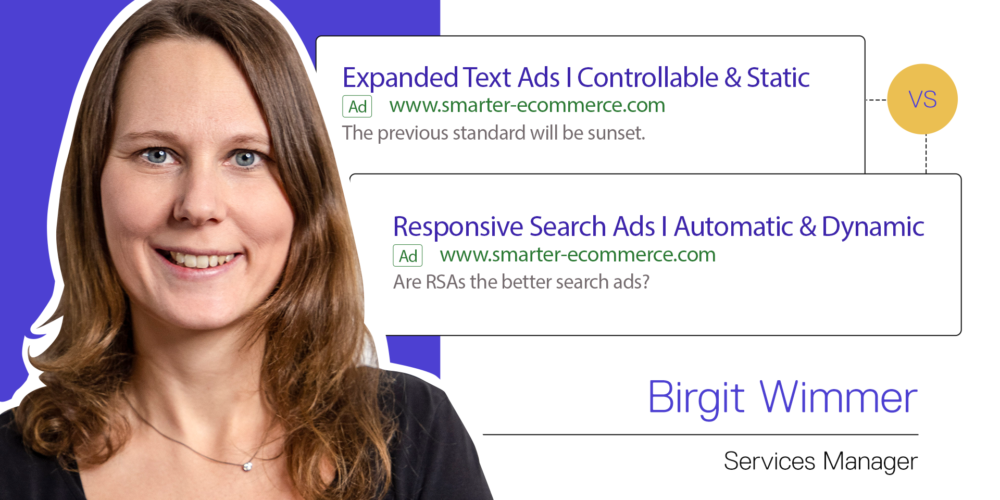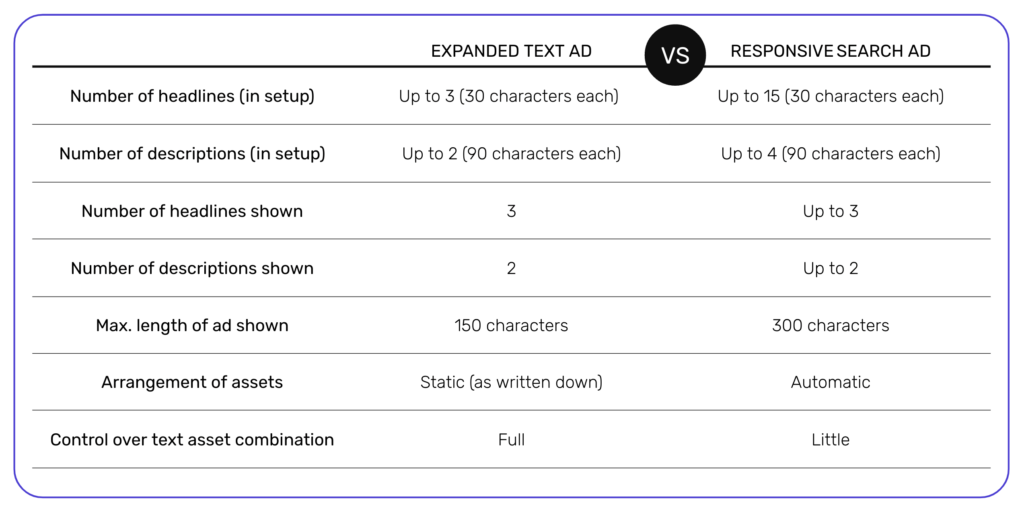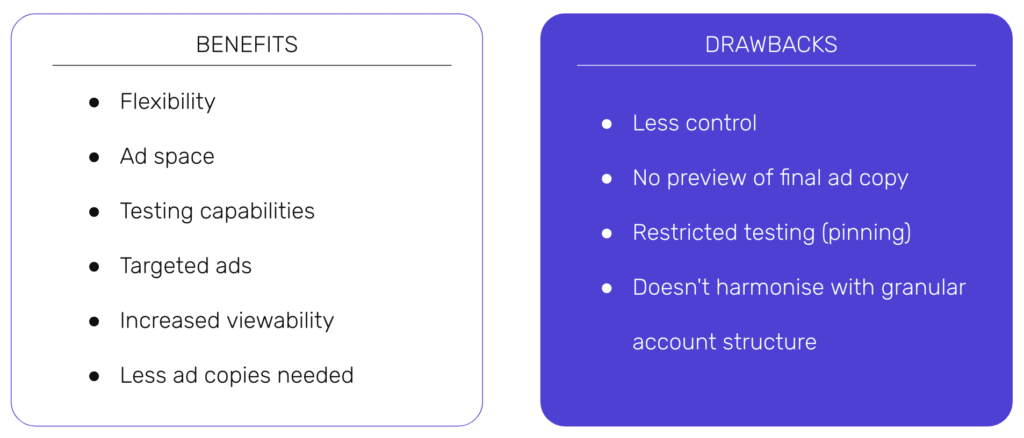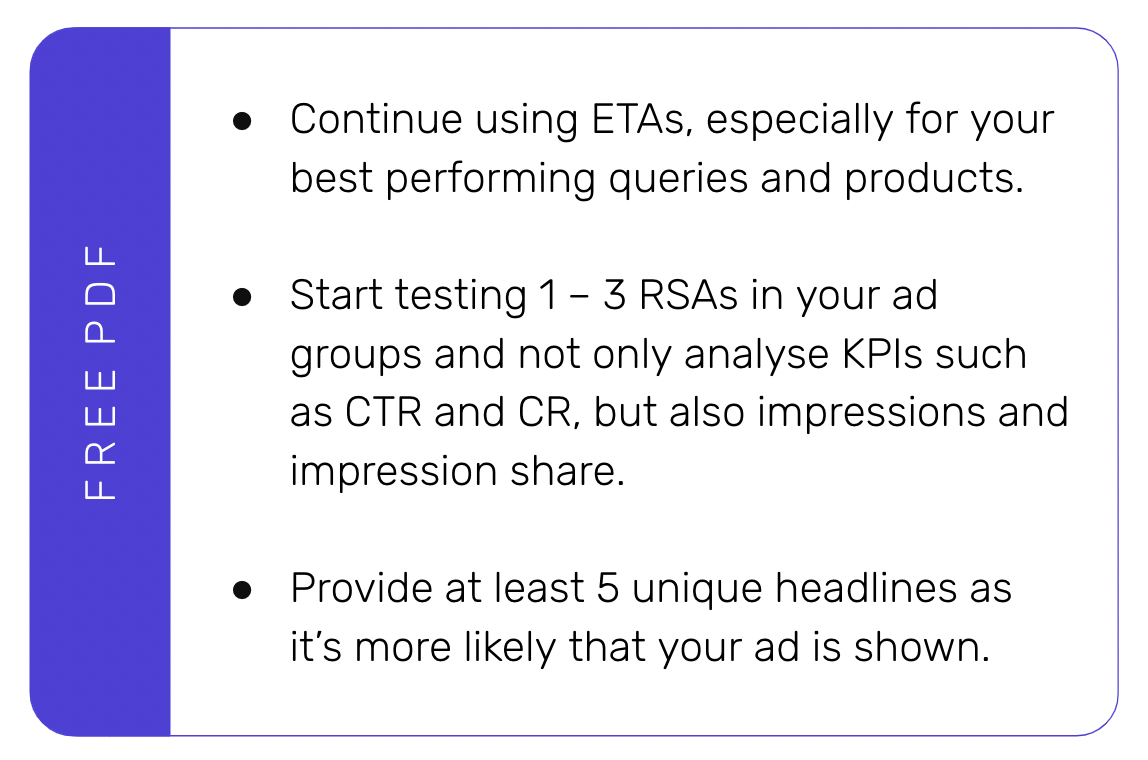Subscribe to join thousands of other ecommerce experts

Update: Expanded Text Ads have been sunset on 30 June 2022. From this date onwards it is only possible to create Responsive Search Ads in Google Ads. Google reasons their decision by highlighting that:
Advertisers that switch from expanded text ads to responsive search ads, using the same assets, see an average of 7% more conversions at a similar cost per conversion. ( Google internal data, Global, 6/3/2021 – 6/12/2021)
Here’s what you need to know in a nutshell:
- You can continue running existing ETAs
- You can report on the performance of ETAs
- It is possible to pause, resume or remove ETAs (editing or creating new ones won’t be possible)
Just to quickly recap, below you can read up on the differences between ETAs vs. RSAs.
Responsive search ads (RSAs) have become deeply ingrained in online marketing campaigns since Google introduced them in 2018. Until then, expanded text ads (ETAs), which were rolled out in 2016, seemed to reign over Google Ads. However, since 18 February 2021, RSAs are the default ad type for Google search ads and ETAs are being pushed aside.
Google gradually introduces new measures and updates that favour automation at scale. What does this mean for advertisers? Less effort and better performance?
As Google Ads is becoming more complex, there’s quite a bit to understand when using different ad formats for search ads – particularly, when looking at expanded text ads vs. responsive search ads.
So, let’s dive right in.
In this blog article, you’ll learn more about:
- What responsive search ads and expanded search ads are
- The difference between expanded search ads and responsive search ads
- The benefits and drawbacks of responsive search ads
- Tips, best practices, and examples for Google’s responsive search ads
- What to keep in mind when using responsive search ads over expanded text ads
Table of Contents
An in-depth look at what responsive search ads are
Responsive search ads (definition by Google), now the default ad type for Google search ads, allow the creation of ads that closely match your potential customers’ searches. To get there, Google automatically tests different RSA versions while taking into account all available text assets as well as possible text combinations. In doing so, Google identifies the best-performing ad copy, which will then be served on the SERP. Note: You can select particular settings dictating the way Google tests your ads.

How do responsive search ads work?
Just like every search ad, responsive search ads consist of headlines, descriptions, and a display URL with path fields. Once provided, Google tests all assets against each other by automatically rotating the individual assets based on the rotation settings you selected (This can result in over 40,000 unique permutations!). Note: Ad rotation settings are to be set on the campaign level. My recommendation here is to go for “Optimise” because it aligns best with how Google’s algorithm works. Remember: Google’s algorithm improves over time and eventually identifies the best performing asset combination – your most promising ad to match a user’s search – and serves it at the right time.

Are responsive search ads worth it?
Do responsive search ads pay off? Do I reach more customers by using this ad type? Both questions leave room for discussion. But generally speaking, responsive search ads could positively influence your performance and lead to further reach. Why? RSAs show up in more searches due to strength and relevance (customised content). This results in higher reach and could lead to more clicks and conversions boosting your performance results. This is not to be generalised as every advertiser may see different developments and patterns in their customers’ search behaviour and the performance of their ads. Also important to keep in mind: Your campaign structure plays an integral role here – the performance of your campaigns based on a granular campaign structure may look completely different from the performance results of campaigns based on a less granular campaign structure.
What is the difference between expanded text ads vs. responsive search ads?
To recap briefly: Expanded text ads (ETAs) were introduced in 2016. This ad format allows you to preview the complete ad. You have more control over the text and how it’s displayed – you can pick and choose which text assets to place in the headlines and descriptions. Plus, the text assets don’t need to be combinable, as is the case with RSAs.
Fast forward to 2018, when Google enriched this ad format to accommodate up to 3 headlines and 2 descriptions. In doing so, the space available to create text for search ads nearly doubled. This enrichment happened roughly at the same time as responsive search ads entered the stage.
Here’s an overview of the differences between expanded text ads vs. responsive search ads:

What are the benefits of responsive search ads?
RSAs offer more flexibility regarding text creation – given the space available – and testing capabilities. Due to Google’s algorithm, you need less time to test your ad copies which are more targeted to your potential customers. Additionally, your ads show up in more searches, potentially attracting more clicks which could lead to more conversions. Boom – better performance is within reach…So it seems.
Also, the option to pin text assets to specific positions in your RSA may seem beneficial at times but keep in mind it’s also restrictive. Yes, pinning ensures the communication of crucial content throughout your ads. However, it also interferes with testing as it restricts the number of possible ad versions Google can generate to identify your most promising one. Hence, you may miss out on potential by pinning text. Note: If you want to pin text assets, pin them to headline 1 or 2 and description 1, respectively. Then, Google can ensure that this particular content will show in your ad.
What are the drawbacks of responsive search ads?
The downside of RSAs is that you have less control over the actual ad text as Google is in charge here – you’re not able to see the final ad copy before it’s served. RSAs are also not the best fit for a granular campaign structure, but rather better suited for generic campaigns.
Let’s have a look at the following example to understand the reasoning behind this statement:
Imagine, you’re a retailer wanting to promote your entire product catalog by taking a granular advertising approach. You create one ad group per product which includes the product title as the main keyword. Corresponding ETAs are in place and work well – you include the main keyword in the headline or description line, making these ads completely tailored to the advertised product.

However, RSA became the new default ad type and you consider using them. But, are RSAs a good fit for you?
When using RSAs, you need to make sure that each headline is unique and combinable with other text assets. Ideally, you use the product title once to avoid repetition. Also, this will ensure that each text asset can be mixed and matched. Without a doubt, these suggested key prerequisites make it more challenging to promote your products effectively.
In other words, you have a lot to keep in mind when working with RSAs. And if you don’t stick to the suggested guidelines on how to use this ad type, you may lose potential customers by showing „irrelevant ads“ – e.g. When showing ads that don’t refer to the product because you don’t include the product title in the text ad at all. A possible workaround could be to pin content (product title) to specific positions. However, this would interfere with how the algorithm works.
In short, RSA may not be the best fit if you have a granular campaign structure in place given it limits testing capabilities and the RSA functionality, which would result in no added value.
Responsive search ads: tips, best practices, and examples
Be smart about how you use the space you have to communicate your offering. Also, ensure to write content that makes sense as every asset of your ad can be assembled in any order.

Using responsive search ads vs. expanded text ads: What you need to keep in mind
According to Google, responsive search ads enable you to reach more potential customers with multiple headlines and descriptions which allow your ads to compete in more auctions and match more queries“. Therefore, it is highly likely that your ad group performance improves because responsive search ads attract more clicks and conversions.
So far so good. In theory, it all seems reasonable. Here’s my take on it:
There’s nothing wrong with using either responsive search ads or expanded text ads. Each ad type has its advantages and disadvantages and every advertiser has different needs to fulfill. Therefore, it’s really up to you to find the approach that works best for you and your business.
Are responsive search ads a good fit for a granular campaign structure?
RSAs are probably not the best fit for a granular campaign structure, particularly when it comes to a structure that consists of single keyword ad groups (SKAGs). The proven method, in this case, is to include the main keyword in the headline. However, RSAs don’t guarantee that because they’re assembled automatically, thus, leaving you without control over the actual text being displayed in the end.
Yes, you have the option to pin content to include your main keyword in relevant places making sure it will be shown in your ad. Nevertheless, as already said, this interferes with the functionality of RSAs. To get a clearer picture of how RSAs might affect your performance results, testing them with pinned content and without pinned content in selected ad groups is something you should consider.
Is responsive a better fit for generic campaigns or a less granular campaign structure?
There are advantages to using responsive search ads for generic campaigns or a less granular campaign structure. This also applies if you have fewer ad groups with different keywords to manage.
- You need less time to create different ads tailored to each keyword.
- It is possible to use keyword insertion to display search queries in your ad texts.
- You can easily combine RSAs with smart bidding.
My two cents: Smart bidding strategies need as much data as possible to function properly. Generally, the trend is to optimise your campaigns for smart bidding and have fewer campaigns with more ad groups containing different keywords. However, such a campaign structure might not be beneficial for every advertiser or campaign type.
To sum it up shortly, both ad types are reasonable to use. It’s just a matter of finding what fits best to your campaign structure and enables you to pursue your goals.
Final Word
The online advertising universe is complex and offers numerous opportunities for retailers to promote their products. And Google plays an active role in this by continuously introducing new features and updates favouring automation at scale.
Automation at scale: What it means for advertisers and performance results
Thanks to automation you can reduce manual effort and allocate resources where it matters most. Particularly, you can focus on strategic matters and dedicate more time to monitoring performance results, driving test initiatives and optimise where you need to.
The expectation that you achieve better results with less effort, however, is something there is no definite answer to. Performance depends on many factors including product and campaign types, campaign structure, industry trends, economic circumstances, etc. One thing is certain though: The more data you have, the better – because you learn where your performance is strong but also where to improve. Once you know where and what to optimise, you can act accordingly.
One last tip: If you’d like to dig even deeper into the topic, make sure you check out our free webinar on RSAs vs. ETAs.

